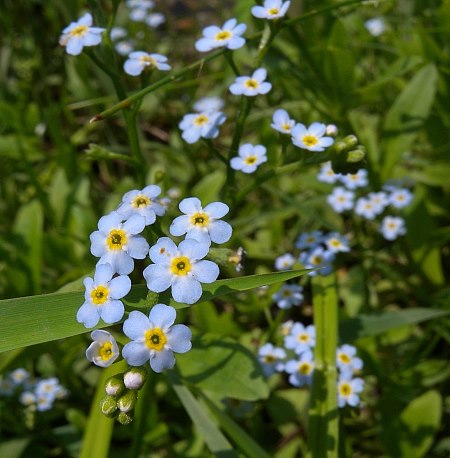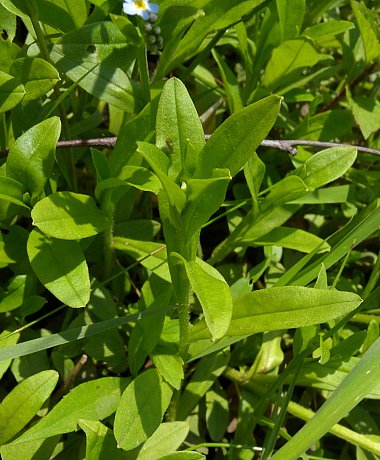
The central stem (and any lateral stems) terminates in a raceme of flowers 2-10" long. The apex of this raceme curves laterally and slightly downward like a scorpion's tail. The central stalk of the raceme is medium green, terete, and covered with appressed hairs. The flowers occur on slender pedicels about ¼" long. Each flower is about 1/4-1/3" (6-8 mm.) across, consisting of a light blue corolla with 5 petal-like lobes, a short tubular calyx with 5 teeth, 5 stamens that are inserted within the corolla, and a pistil with a single style. The opening of the corolla is narrow and it is surrounded by a ring of yellow. The calyx is medium green and covered with appressed hairs; its teeth are shorter than the calyx
Cultivation: The preference is full or partial sun and wet to moist conditions. This wildflower adapts to ordinary garden soil containing loam or clay-loam if it is kept sufficiently moist. Shallow standing water is tolerated.
Range & Habitat: True Forget-Me-Not rarely naturalizes in Illinois, where it is found primarily in the NE section of the state. It was introduced into North America from Eurasia as an ornamental garden plant. While True Forget-Me-Not has not been invasive in Illinois thus far, it has become aggressive in some areas of northeastern United States. Habitats consist of low areas along springs, ponds, and slow-moving streams where the supply of moisture is more or less stable.
Faunal Associations: According to Müller (1873/1883) in Germany, the flowers of True Forget-Me-Not attract small butterflies and dance flies (Empis spp.); these insects feed on the nectar. Two polyphagous aphids, Myzus persicae and Rhopalosiphum padi, have been observed to suck plant juices from Myosotis spp. (Forget-Me-Not species) in Illinois (Hottes & Frison, 1931). When this wildflower forms colonies of plants along wetlands, it provides cover for snakes and small animals.
Photographic Location: Along a pond or slow-moving stream at the Toledo Botanical Garden in Toledo, Ohio.

Comments: This is one of the blue-flowered Forget-Me-Not species (some others have white flowers). True Forget-Me-Not is a larger plant with larger leaves and larger flowers (6-8 mm. across) than the native Myosotis laxa (Small Forget-Me-Not), which has flowers about 3-4 mm. across. Another species that is sometimes cultivated, the non-native Myosotis sylvatica (Garden Forget-Me-Not), has a very similar appearance to True Forget-Me-Not. Garden Forget-Me-Not differs by having spreading hooked hairs on its calyx, and its calyx teeth are as long or longer than the calyx tube. Furthermore, its calyx teeth are more lanceolate and pointed than those of True Forget-Me-Not, which are more ovate and blunt.